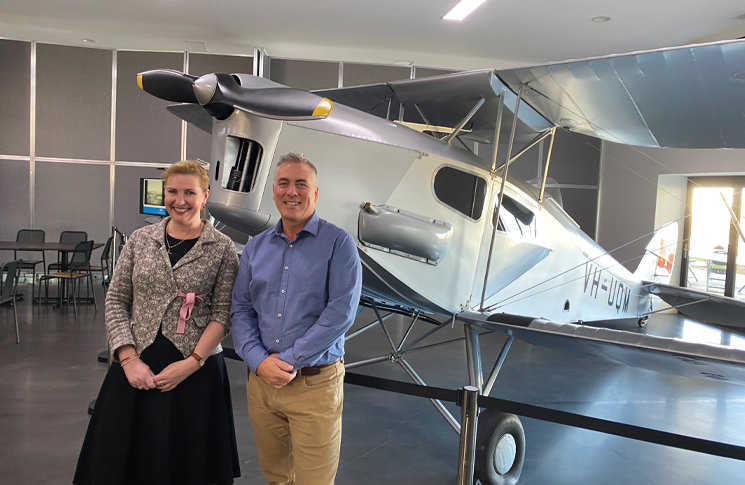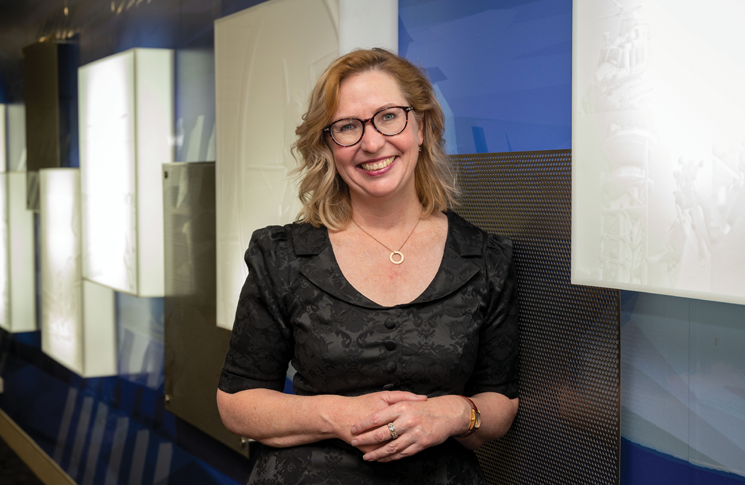CASA’s new CEO and Director of Aviation Safety (DAS) Pip Spence has a long history of observing and cooperating with the aviation sector. She brings a professional interest in aviation and a talent for resolving problems to her new role. Here she discusses her approach to the job.
What are your priorities for CASA?
Probably the biggest thing is to get on with what we said we would do. Coming here, I knew there was a lot of change going on. I was thinking that was largely in the regulatory space, but I hadn’t quite realised the significance of the changes CASA was going through internally. A lot of that is focussed on improving our consistency and responsiveness to industry which is important to me.
I’d like to think the CASA I lead is a respected regulator, a transparent regulator. Inevitably, some people won’t like a decision, but I never want people to be able to say, ‘We have no idea why they decided what they did’.
I want to make sure we’ve got a really sophisticated approach to risk management that is embedded within the organisation. That means everything we do has got to be owned by the executive and focussed on the things that are important to aviation safety.
I want to make sure we focus on what genuinely matters and act in a way that helps not hinders safety – allowing pilots, engineers, airports, airlines and everyone that plays a part in aviation to put their energy and effort into making their operations and businesses as safe as they can be.
Success for me also means knowing we won’t always get it right, but it’ll never be deliberate. We have to be able to acknowledge when we got it wrong, apologise and work out what we need to do to move on.
Industry shouldn’t think we’re their friend, but they shouldn’t be scared of us.
That’s a very similar thing to aviation safety in general, isn’t it – acknowledging that human error is universal?
Exactly. And for that to work, a ‘just culture’ is such an important principle. If someone does do something wrong, they shouldn’t feel they’re going to be held up as a scapegoat or criticised publicly. As an organisation we need to support anyone who, for whatever reason, made an honest mistake.
What are your early impressions of the relationships with industry?
Overall, quite good. While it’s still early days, I’m feeling very positive about our links with industry.
So far I’ve been able to talk to a good cross-section of industry representatives, through the Regional Aviation Association of Australia, the General Aviation Advisory Network and the Aviation Safety Advisory Panel and most recently at Rotortech in Brisbane and the ‘meet the board event’ in Darwin. The feedback on my priorities and general approach has so far been well received. It would be disingenuous to say no-one has raised concerns with me – but that’s encouraging in itself as it shows that people are willing to engage constructively.

How do you describe your leadership style?
While I recognise my style is a bit different to [previous CEO] Shane Carmody, we do have a few key areas where we are in lock step, such as fairness and taking firm but informed positions.
I like to listen to what people have to say. I don’t go into this job thinking that I know everything. Being consultative and collaborative is really important for me. I’ll listen to everyone and hear what they’ve got to say, but the buck does stop with me in terms of actually making decisions.
I feel incredibly lucky to have this job, but know that there’s a lot of responsibility because I’ve got to find a way of making the right decisions. In doing this I’ll work closely with the senior management team and the Board. But, at the end of the day, there are a lot of things that sit within the powers of the DAS.
Has your previous work taught you to be a quick learner?
Yes. I do think that I can get across complex issues quite quickly, often drawing on parallels with other areas where I have worked.
One of the steepest learning curves for me was when I moved to the Department of Communications to work on the National Broadband Network. As with aviation, its technically challenging, there’s a lot of complex legislation and a lot of people who know that detail inside out. If you come in and say, ‘We’re going to build a national broadband network and fundamentally reform the legislative basis for the sector’, you can’t then say, ‘I’ll come back to you in 6 months when I’ve got my head around the issues’.
What contact with aviation have you had in your previous career?
Early in the nineties, I joined the then Department of Transport and Communications as a graduate economist working in the aviation team in the Bureau of Transport and Communications Economics. That was soon after the Government had implemented major microeconomic reforms of the aviation sector – so a big period of deregulation – and we were looking at what that meant for the health of the industry, both domestic – including general aviation – and international.
So that was my grounding in the sector. And then I moved from the Bureau into the main area of the department and worked on international aviation issues, such as air services agreements. After that, I went to work on, first, a scoping study and then the sale, of the federal airports.
I’ll listen to everyone and hear what they’ve got to say, but the buck does stop with me in terms of actually making the decisions.
You worked on planning the second airport for Sydney?
I worked on the EIS [environmental impact statement] at the time when the government was considering Badgerys Creek and Holsworthy as possible sites.
Early in 1997 I went to the minister’s office as a liaison officer and then adviser for aviation. After the 1998 election, I went back to the Transport Department where I worked in the area that had oversight for the Airservices Australia and CASA, which gave me a great grounding in many issues that are still relevant today. Interestingly, that was at the time CASA began the reform from CARs [Civil Aviation Regulations] to CASRs [Civil Aviation Safety Regulations], so it’s great to come to CASA and see that process has almost been completed.
What other ways has your public service experience prepared you for leading CASA?
For the last 18 months at the Infrastructure Department, I was the chief operating officer which meant I’ve had the opportunity to get to the heart of what makes an organisation healthy.
I’ve also worked as a regulator and with other regulators; for example, as Deputy Secretary Transport, I was responsible for the team in the Department that approves which vehicles are allowed to operate on our roads.
I’ve also already been able to see some parallels in work that I was doing in the Department around the introduction of autonomous vehicles, including looking at the regulatory framework to support this new technology operating in our transport systems.
How does the relationship between CASA and its aviation stakeholders compare with others you’ve seen in your public sector career?
Having worked with a few of the other regulators in the transport portfolio, such as the Australian Maritime Safety Authority, the National Heavy Vehicle Regulator and the National Rail Safety Regulator, there are certainly a lot of similarities.
One thing in particular is that the way the regulator engages with its stakeholders can never be a one-size-fits-all approach. We are all dealing with industries that are made up of a range of operators who have different operating models, and we have to be very careful that we don’t end up with a ‘cookie cutter approach’ when engaging with stakeholders. We need to think about who we are talking to and what their pressures are.
With parts of the domestic aviation sector in crisis because of COVID-19, what approach does CASA need to take to avoid making things worse?
First and foremost, we need to remember our regulatory philosophy. Without compromising safety, now more than ever we need to be a proportionate and risk-based regulator that takes into account all relevant considerations, including cost.
We also need to be ready to support a reopening of the sector. We need to work with the airlines as they bring aircraft back into the operations after an extended period on the ground.
Also, what does it mean for flight crew who haven’t been operating at the same frequency as previously?
And mental health – you see the ups and downs in the sector, when borders suddenly shut. I don’t think you can underestimate the stress that a lot of people in aviation have been through. And that means, as a regulator, we’ve got to be mindful of context.
We are making sure we’re working very closely with our aviation policy group partners – the Department, Airservices, ATSB and the RAAF. We all bring our own perspective into it but we need to understand what everybody else is doing. You can’t ignore the financial and mental strain that everyone in the aviation sector has been under.
The way the regulator engages with its stakeholders can never be a one-size-fits-all approach.
What are your thoughts on the importance of culture in an organisation and in a sector, and the relative importance of setting the tone and the fine details of writing the regulations?
I think culture is just as important as setting the tone of the regulations. Our regulatory philosophy has to go hand in hand with the regulations themselves.
First and foremost, I want a culture that supports respect and engagement. I want to lead an organisation that is always looking for opportunities to improve what we do and how do it. I want us to be able to work collaboratively with the industry that we regulate, to be open and transparent in our decision-making.
Within the organisation, I want everyone to be proud to say they work in CASA, and that’s most likely to happen when we all feel that our contribution is valued and we all play an important role in the engine that delivers safe skies for all.
I feel incredibly lucky to have this job, but also feel there’s a lot of responsibility because I’ve got to find a way of making the right decisions and working with the senior management team and the board.
Therefore, if the regulator knows what it has to do and is focused on doing it, will the outcome be a stronger and safer relationship?
Yes, industry shouldn’t think we’re their friend, but they shouldn’t be scared of us. And they generally need to believe the regulatory philosophy is not just a piece of paper. It actually sets out how we go about our business. And that goes to the transparency factor as well – we can’t be respected if people don’t understand what we do.
I want to leverage the respective strengths and skills of industry and CASA to drive safety, but also a vibrant aviation industry.
Is there anything in aviation that keeps you awake at night?
There are lots of things that fall into that category but I do feel we’ve got a solid base within CASA to deal with issues and an industry that’s very focussed on safety. I’m obviously very mindful of the fact that there are times when I’m going to have to take a decision based on the balance of probabilities, and those decisions are going to impact on people’s lives and livelihood. It’s a big responsibility which I don’t take lightly.


